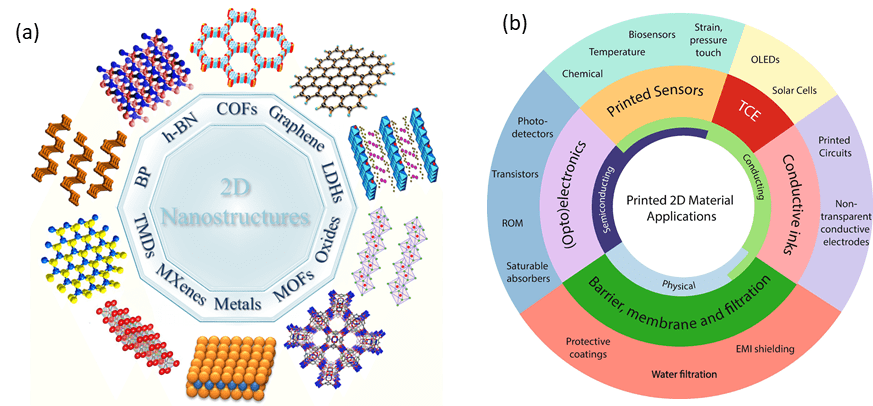Why we should learn two dimensional (2D) layered materials? To answer that question, let me tell you several reasons why 2D layered materials have attracted a lot of attention. First of all, it is from the application point of view. Due to their mechanical strengths, the 2D layered materials are promising for flexible electronics. The tunable optical properties by number of layers modification also offers possibility for optoelectronic devices application. Furthermore their degenerated spins and valleys are tempting for future spintronic and valleytronic technologies. From fundamental aspect, the 2D materials also offer intriguing phenomena which can not be observed in three dimensional materials such as quantum confinement and fluctuation, the existence of various excitons as well as their coupling to electron and phonon, and the various possible phase transitions
For illustration, figure 1 displays various types of 2D materials [1] and their possible applications [2].

If you are interested in the 2D materials please feel free to contact me via email [email protected] or read our previous publications
Publications:
- Uniaxial strain-induced electronic property alterations of MoS2 monolayer. A Setiawan, I P Handayani and E Suprayoga, Adv. Nat. Sci: Nanosci. Nanotechnol. 12 045016, 2022, https://iopscience.iop.org/article/10.1088/2043-6262/ac4aed/meta , preprint version at https://arxiv.org/ftp/arxiv/papers/2201/2201.00500.pdf
- Optical and electrical characterization of WS2 multilayer on flexible PET substrate, Ismudiati Puri Handayani, Athalya Maida Utama, Memoria Rosi, Akram Muhamad Rafli, Adrian Setiawan, Mater. Res. Express 8 (2021) 026405, https://doi.org/10.1088/2053-1591/abe54f
- Electronic properties of hybrid WS2/MoS2 multilayer on flexible PET, Faraduan , I P Handayani , D A Diandra, H Delima and IW Fathona, Mater. Res. Express 8 (2021) 016409, https://doi.org/10.1088/2053-1591/abdc3a
References:
[1] Liang Cheng,Xianwen Wang,Fei Gong,Teng Liu,Zhuang Liu, 2D Nanomaterials for Cancer Theranostic Applications, https://doi.org/10.1002/adma.201902333
[2] Leonard W. T. Ng, Guohua Hu, Richard C. T. Howe, Xiaoxi Zhu, Zongyin Yang, Christopher G. Jones & Tawfique Hasan, Applications of Printed 2D Materials, https://link.springer.com/chapter/10.1007/978-3-319-91572-2_6
